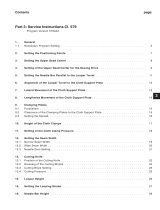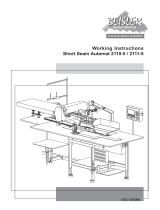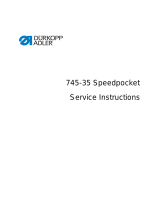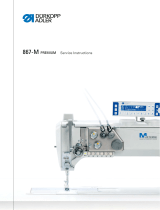
5. Function Displays and Error Messages
5.1 Display of the Operating Aids
Display Explanation Remedy
P? Invalid program selected Reset the “ Program ”switch
975A01 Display of the program version —————-
Σ =xxxx Piece counter —————-
5.2 Error Messages of the Sewing Program
Display Explanation Remedy
ERROR 10 Phase direction of rotation incorrect Power supplie x1: change phases L1+L2
Bridge X3.1 - X3.2 is missing.
See Componect Connection Diagram !
ERROR 11 Air pressure too low Increase the compressed air supply.
ERROR 12 Base position-left is missing Bring the clamping table into the base
position with the hand crank.
ERROR 13 Base position-right is missing Bring the clamping table into the base
position with the hand crank.
ERROR 14 Thread lever is not up Turn the handwheel.
By units with 2 synchronizers, Interchange synchronizer.
also synchronizers interchanged
ERROR 15 Hold-down/left is displaced Bring into the base position manually.
ERROR 16 Hold-down/right is displaced Bring into the base position manually.
ERROR 17 Machine head is not up Check the cylinder.
(inspite of having been called up)
ERROR 18 Needle plate is not down Check the cylinder
(inspite of having been called up)
ERROR 19 Light barrier/left is not free Remove sewing piece or foreign object.
ERROR 20 Light barrier/right is not free Remove sewing piece or foreign object.
ERROR 21 Interior slide/left is not to the back Bring into position manually.
ERROR 22 Interior slide/right is not to the back Bring into position manually.
ERROR 23 Machine head is not down Check the cylinder.
(inspite of having been called up)
ERROR 24 Needle plate is not up Check the cylinder.
(inspite of having been called up)
ERROR 25 Keypad pressed when turning on Re-start the sewing unit.
ERROR 26 Pedal/left pressed when turning on Re-start the sewing unit.
ERROR 27 Pedal/right pressed when turning on Re-start the sewing unit.
ERROR 28 Both switches/ hold-down left triggered Check the limit switches.
ERROR 29 No switches/hold-down left triggered Check the limit switches.
ERROR 30 Both switches/hold-down right triggered Check the limit switches.
ERROR 31 No switches/hold-down right triggered Check the limit switches.
ERROR 32 Both switches/needle plate triggered Check the limit switches.
ERROR 33 No switches/needle plate triggered Check the limit switches.
Continued on the next page !
18



























